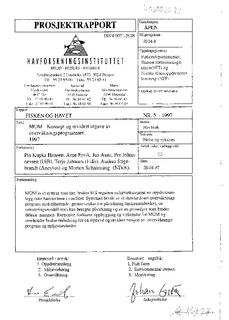MOM : konsept og revidert utgave av overvåkingsprogrammet 1997
Hansen, Pia Kupka; Ervik, Arne; Aure, Jan; Johannessen, Per; Jahnsen, Terje; Stigebrandt, Anders; Schaaning, Morten
Research report
Permanent lenke
http://hdl.handle.net/11250/113317Utgivelsesdato
1997Metadata
Vis full innførselSamlinger
- Fisken og havet (1958- ) [700]
Sammendrag
This report describes a management system (MOM) which can be used to regulate the
environmental effects of marine fish farming, ensure good rearing conditions for the
fish and avoid pollution. The latter part of the report contains a manual for the
monitoring programme.
MOM is based on a general concept for regulating environmental impact and its main
elements are: simulation of impact (model), control of the impact (monitoring
programme), and permissible limits for environmental impact (environmental quality
standards (EQS)). Two terms link the three elements: the degree of exploitation and
the leve1 of monitoring. Through the two terms the monitoring effort is adjusted
according to the environmental impact on the site.
MOM is based on agreement that fish farm sites should not deteriorate over time and
that the impact must not lead to the extinction of the benthic infauna beneath the farm.
The system recognizes three degrees of exploitation of a site, each of which is linked to a leve1 of monitoring. If the third degree of exploitation is exceeded the site is being overexploited.
The monitoring programme consists of three types of investigation: A, B and C. The
A-investigation is a simple sedimentation measurement beneath the net pens. The B-investigation is a characterization of the sediment conditions beneath the fish farm,
and a set of EQS has been set in MOM. The C-investigation is a sediment fauna study and general EQS for infauna investigations are used.
MOM distinguishes between three zones of impact around a fish farm: the local, the
intermediate and the regional impact zones. The environmental impact is largest in the
local impact zone where the larger particles settle. Here both the A-, the B- and the C-investigations are used. In the intermediate impact zone the impact is less and primarily due to the sedimentation of smaller particles. This zone is monitored by the B- and C-investigations. In the regional impact zone the more sensitive areas are
monitored by the C-investigation.
The latter part of this report is a manual for the monitoring programme including
EQS. It is essential that the persons who perform the B-investigation should have
experience of sediment investigations. The C-investigation can only be performed by
specialists.
MOM may be part of the scheme for regulating marine fish farming. The system is
intended to keep the environmental impact from fish farming within agreed limits and
avoid detrimental effects. Improved environmental conditions may increase fish
production, and documentation of rearing conditions can be provided. NORSK SAMMENDRAG: Rapporten beskriver et system (MOM) som kan brukes til å regulere miljøvirkningene fra marine oppdrettsanlegg, slik at fisken sikres gode leveforhold og slik at unødig miljøpåvirkning unngås. Siste del av rapporten inneholder en brukerveiledning for
overvåkningsprogrammet.
MOM bygger på et generelt konsept for regulering av miljøpåvirkning.
Hovedelementene er et prognoseverktøy som beregner miljøvirkningene av et
oppdrettsanlegg (simuleringsmodell), et kontrollverktøy som undersøker den faktiske
påvirkningen (overvåkningsprogram) og grenseverdier for tillatt påvirkning
(miljøstandarder). Disse tre elementene er integrert i ett system, og forkortingen
MOM står for Matfiskanlegg, Overvåkning og Modellering.
MOM legger til grunn at lokalitetene skal kunne brukes over lang tid uten at
påvirkningen blir større enn at gravende bunndyr kan leve under anleggene. Systemet
opererer med tre utnyttelsesgrader for oppdrettslokaliteter, og for hver
utnyttelsesgrad svarer et overvåkningsnivå. Dersom tredje utnyttelsesgrad
overskrides, er lokaliteten overbelastet.
Overvåkningsprogrammet består av tre typer undersøkelser: A, B og C. A-undersøkelsen
er en enkel måling av sedimentasjonsraten under anlegget, og nytter
ikke noen miljøstandard. B-undersøkelsen er en kartlegging av sedimenttilstanden
under anlegget og nytter egne miljøstandarder utviklet for MOM. Den er justert på
grunnlag av utprøvingen ved 31 oppdrettsanlegg. C-undersøkelsen er en
bunndyrsundersøkelse langs en gradient fra anlegget og utover i resipienten. Den
bruker generelle miljøstandarder for bunndyrsundersøkelser.
MOM skiller mellom nærsone, overgangssone og fjernsone. Påvirkningen er størst i
nærsonen der de store partiklene bunnfeller. Her nyttes både A-, B- og C-undersøkelse.
Overgangssonen belastes mest av svevepartikler, og påvirkningen er
mindre enn nær anlegget. Denne sonen overvåkes med C- og i noen tilfeller B-undersøkelse.
Fjernsonen påvirkes mest av oppløste næringssalter, og følsomme deler
av den overvåkes med C-undersøkelsen. Fjernsonen inngår ellers i den generelle
kystovervåkningen.
Siste delen av rapporten er en brukerveiledning for overvåkningsprogrammet og miljøstandardene. Det er en forutsetning at de som skal utføre B-undersøkelsen har
fått godkjent at de har gjennomgått kurs. C-undersøkelsen kan bare gjennomføres av
spesialist.
MOM kan inngå som en del av reguleringen av oppdrettsnæringen og kan bidra til å
holde miljøpåvirkningen fra oppdrettsanleggene innenfor omforente grenser slik at unødige miljøproblemer kan unngås. Bedret miljø i anleggene kan forbedre
produksjonen, og det blir mulig å dokumentere hvilke miljø fisken har levd i.
Utgiver
HavforskningsinstituttetSerie
Fisken og havet1997-05
